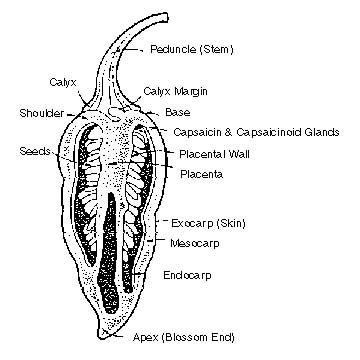Scoville Units

We
enjoy peppers, an acquired taste! The hotter the better although
there is a limit. We grow all sort of peppers and use them on all
of our cooking. During the winter, we actually use the dried
peppers from the previous summer!
Spicy peppers contain a substance called capsaicin.
Capsaicin is found contently in the interior tissue to which the seeds adhere. This is what makes them taste hot.
Concentrated in the veins of the fruit, the compound stimulates your nerve endings making your brain "think" that you are in pain.
The brain responds by releasing substances called endorphins (like distance runners experience), which are similar in structure to morphine.
A mild euphoria results making peppers mildly addictive because of this hot pepper "high".
Ask any pepper-head (and you don't have to run 20 miles).
 Capsaicin is a colorless, crystalline, bitter compound present in capsicum [Previously referred to as capsicine]. It has a molecular weight of 305.46. Capsaicin has a Melting Point of 65 C, Boiling Point of 81 C, Vapor Pressure of 40 and a Vapor Density of 1.59 (Air=1).
Capsaicin is a colorless, crystalline, bitter compound present in capsicum [Previously referred to as capsicine]. It has a molecular weight of 305.46. Capsaicin has a Melting Point of 65 C, Boiling Point of 81 C, Vapor Pressure of 40 and a Vapor Density of 1.59 (Air=1).
The range in capsaicin content in the pericarp of an average capsicum is about 0.17% to 0.58% and the inner sheath is 6.6% to 7.7%; color is concentrated mostly in the pericarp. Chili seeds contain 19% oil with 0.024% capsaicin content. The percentage of capsaicin in the capsicum plant depends on the species, geographical origin and the climatic conditions.
Capsaicin is produced by glands at the juncture of the placenta and the pod wall. The capsaicin spreads unevenly throughout the inside of the pod and is concentrated mostly in the placental tissue.
The seeds are not sources of heat, as commonly believed. From one Kg. of cayenne pepper for example, approximately 2.13 g. of crude capsaicin can be isolated, which is about 20 times the amount found in paprika.
A Scoville Unit is a measurement of capsaicin level in a particular pepper or variety. Although peppers can vary from pod to pod, plant to plant, variety to variety, and even season to season, listed below is an approximate scale for several varieties of peppers:
Scoville Units: Includes
0-100: Bell/Sweet
500-1000: New Mexican
1,000-1,500: Espanola - Sandia
1,000-2,000: Ancho & Pasilla
1,000-2,500: Cascabel & Cherry & MiraSol (Pueblo)
2,500-5,000: Jalapeno
5,000-15,000: Serrano
15,000-30,000: de Arbol & MiraSol Extra Hot, Barker
30,000-50,000" Cayenne, Tabasco
50,000-100,00: Chiltepin
100,000-200,000: Scotch Bonnet & Thai (Locally called Dynamite)
200,000 to 300,000: Habanero
575,000: Red Savina" Habanero
Around 16,000,000: Pure Capsaicin.
*The "Red Savina" Habanero has been tested at over 577,000 Scoville units! This is so much hotter than the normal Habanero chile pepper, that the "Guinness Book of Records" have accepted it as "the hottest chile pepper" in the world. Even now, breeders are attempting to beat this. The new Francisca Habanero is said to be hotter still!
* Courtesy of Patrick Sprague